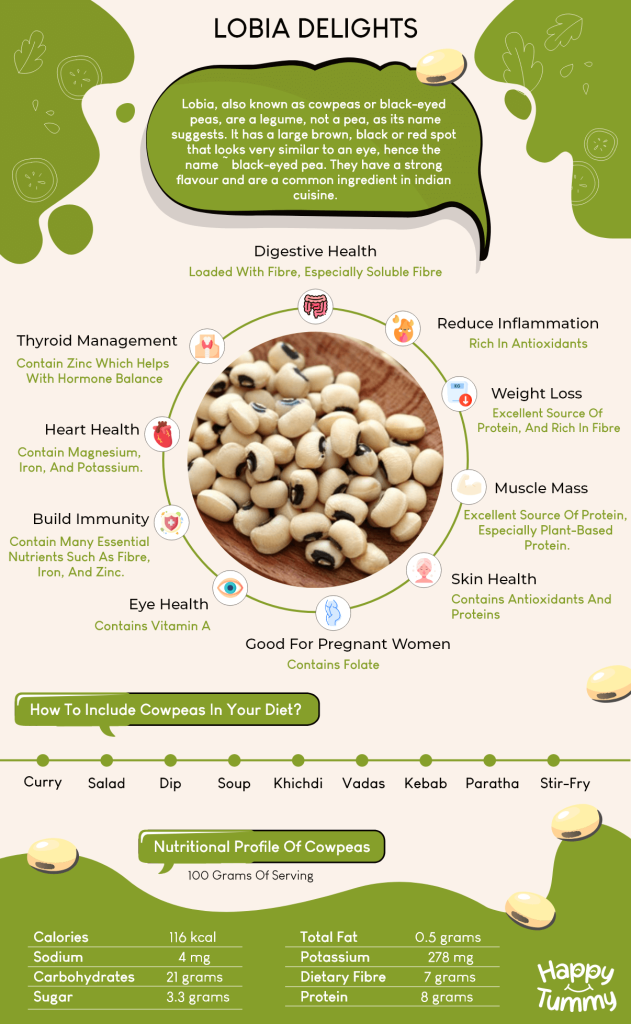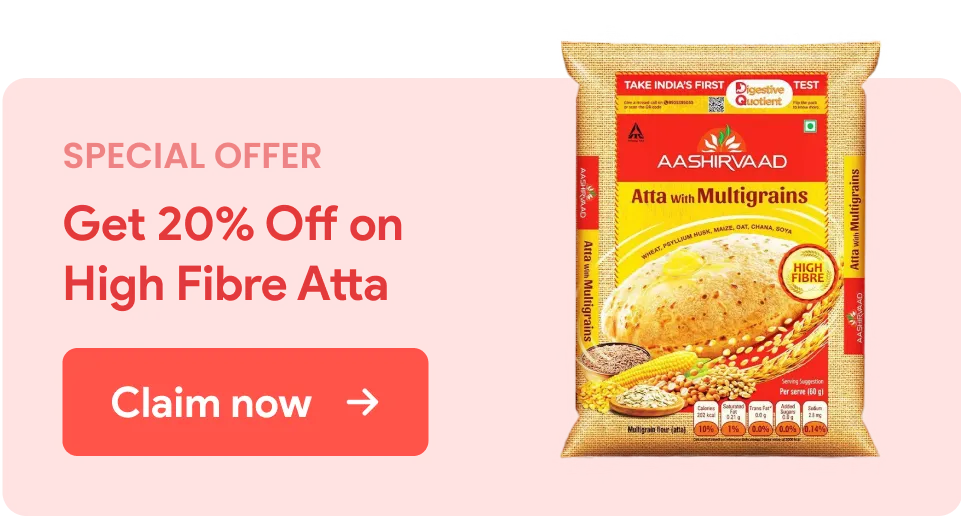Table of Contents
In Indian families, weekends are often the days to try different dishes and recipes. Most Indian mothers make special dishes, like rajma chawal, chole bhature, and more.
Ever wonder why? These things take a lot of time to cook, as you need soaking time before you can boil them. All these legumes are highly nutritious and offer numerous health advantages.
One such legume is cowpeas, commonly known as lobia in Indian culture. This legume is generally less popular than kidney beans (rajma) or chickpeas (chole). However, they are a superfood packed with healthy nutrients.
They may look similar to rajma but are generally smaller and white. They even taste different from their similar-looking legume.
If you have not tried this amazing, delicious, and nutritious ingredient yet, you will surely like to try it once you read this healthy article.
So, let’s begin by exploring everything about cowpeas.
What is a Lobia?
Lobia, also known as cowpeas or black-eyed peas, are a legume, not a pea, as its name suggests. This ingredient is grown all around the world and is pale in colour.
It has a large brown, black or red spot that looks very similar to an eye, hence the name – black-eyed pea. They have a strong flavour and are a common ingredient in Indian cuisine.
Nutritional Profile of Cowpeas
Let’s look at the nutritional profile of black-eyed peas that you can get in 100 grams of serving [1]:
| Calories – 320.4KCal | Total Fat – 1.15 grams |
| Sodium – 13.68 mg | Potassium – 1241 mg |
| Carbohydrates – 54.62 grams | Dietary fibre – 11.54 grams |
| Sugar – 1.6 grams | Protein – 20.36 grams |
Health Benefits of Lobia

Lobia is a superfood and is highly advantageous for our bodies. Below are some health benefits this fantastic ingredient offers that should be a must-have in your kitchen.
#1. Digestive Health
A weak digestive system is a common problem these days. If you want to control this issue with diet, nothing can beat cowpeas.
Rongi is loaded with fibre, especially soluble fibre, which helps solve constipation problems. It helps promote healthy digestion and a happy tummy [2].
If you want to know how your digestive health is performing, take the Digestive Quotient Test by Aashirvaad Atta. You will determine your tummy health and know everything about it by answering simple questions.
#2. Weight Loss
Rongi or cowpeas are often known as vegetarian meat and are an excellent source of plant-based protein. They are also rich in fibre; hence, they are an amazing addition for people looking for a weight loss diet plan.
It is a low-calorie food offering protein, folate, and iron. Moreover, the fibre in these legumes can help remove toxins, cellulite and accumulated fats, thus resulting in weight loss [3].
If you want to know its fibre content, do check it out on My Meal Plan by Aashirvaad Atta. Using this tool, you can also check the fibre content in different recipes you can make from this ingredient.
You can also try Aashirvaad Multigrain Atta with the richness of six whole grains. It is fibrous and can also support you in your weight loss journey.
#3. Heart Health
This little black-eyed pea is also said to improve cholesterol levels and help promote heart health. They contain many minerals and vitamins, such as magnesium, iron, and potassium.
All these nutrients are great for maintaining healthy blood pressure levels. They are also a natural source of flavonoids for healthy heart muscles and lower inflammation.
Besides, fibre and protein may also help lower LDL or bad cholesterol levels. Rongi also has a compound called phytosterols, ensuring the lipid profile is always intact [4].
#4. Lobia offers Muscle Mass
Cowpeas are an excellent source of protein, especially plant-based protein. Hence, they are a good addition for vegetarians and vegans.
Moreover, this protein is also needed for our muscles’ overall growth and repairs. Thus, it helps in offering the muscle strength our bodies need.
#5. Build Immunity
Cowpeas contain many essential nutrients, such as fibre, iron, and zinc. Besides these, they are also a rich source of polyphenols. They are components that act as antioxidants.
Our bodies need these antioxidants for various reasons, such as preventing cell damage and protecting against diseases [5].
#6. Reduce Inflammation
These legumes are considered rich in antioxidants that help protect our bodies against oxidative stress and thus reduce inflammation[7].
#7. Lobia helps in Thyroid Management
Thyroid happens because of an imbalance of certain body hormones. It is said that including beans, such as cowpeas, can help manage thyroid function as they contain zinc, which helps with hormone balance [8].
#8. Good for Pregnant Women
Lobia is said to be great for expecting mothers. It contains folate that is essentially required during the first trimester. It helps in developing the baby’s body organs.
Moreover, a pregnant lady’s body also requires a lot of iron and protein, which is abundant in this legume [6].
#9. Boosts Skin Health
If you face common skin issues, rongi should be your go-to ingredient in your diet. It contains antioxidants and proteins that can help with ageing and damaged and dull skin.
Moreover, the fibre in them helps in maintaining a healthy gut and restoring the natural skin glow. The antioxidants help repair damaged skin cells and maintain elastic, tight, and young skin.
#10. Lobia Enhances Eye Health
Lobia contains very high levels of beta-carotene. Our bodies’ convert this compound into Vitamin A. Vitamin A is the essential nutrient for healthy eyes [9].
How to Include Cowpeas in Your Diet?
Lobia is a very versatile ingredient that can be used in many ways. Some of the ways you can add are:
- Curry
- Salad
- Soup
- Stir-fry
- Kebabs
- Classic lobia chawal
- Patties
- Cutlets
- Vadas
- Fritters
- Khichdi
- Stuffed parantha
- Dip
Lobia Shami Recipe
Here is an interesting recipe for introducing lobia to your family.
Ingredients:
- Lobia – 1 cup soaked and boiled
- Bread slices – 4-5
- Green chillies – 2-3 finely chopped
- Ghee – 3 teaspoon
- Shahi jeera – ½ teaspoon
- White pepper powder – ½ teaspoon
- Salt – to taste
- Ginger – 1 inch chopped
- Garam masala powder – ½ teaspoon
- Mint leaves – 1 tablespoon chopped
- Cashew nuts – 10 – 12
- Chironji – 1 tablespoon
- Onion – 1 thinly sliced
- Lemon – 1 cut-in round slices
Method:
- Heat 1 teaspoon ghee in a non-stick pan.
- Add green chillies and ginger and saute for a minute
- Add shahi jeera and saute.
- Add boiled rongi and saute for 2-3 minutes.
- Mix salt and white pepper powder and turn off the heat.
- Cut the bread slices into small cubes and discard the sides.
- Soak the bread in water, squeeze it, and keep it on the side.
- Add the lobia mixture to the bread and mix well.
- Next, add garam masala and mint leaves.
- Heat the remaining ghee in the pan and fry cashew nuts and chironji.
- Chop them once done and mix to lobia mixture.
- Apply some ghee on your palms, take a small mixture and make tikkis.
- Fry these tikkis with some ghee or oil till golden brown.
- Transfer the tikkis to a plate and garnish with lemon wedges and onion slices.
Lobia Salad Recipe
Make this healthy black-eyed peas salad recipe for a complete nutritious meal.
Ingredients:
- Lobia – 1 cup
- Water – 2 cups
- Cucumber – 1 cup chopped
- Tomatoes – ½ cup chopped
- Onion – ¼ cup chopped
- Coriander leaves – 2 tablespoons chopped
- Sunflower seeds – ¼ cup
- Olive oil – 2 tablespoon
- Lemon juice – 1 tablespoon
- Jeera powder – ¼ teaspoon
- Pepper powder – ½ teaspoon
- Salt – to taste
- Boiled potato cubes – 1 cup
Method:
- Cook lobia in 2 cups water and keep it aside.
- Add lemon juice, olive oil, pepper powder, and salt in a mixing bowl and mix well.
- Add onions, cucumber, tomatoes, and potato to the oil mixture. Mix it well to ensure the dressing is evenly coated with the veggies.
- Add boiled lobia, coriander leaves and sunflower seeds to this mixture.
- Give it a mix and serve it immediately.
Side Effects of Cowpeas
Even though this legume is considered to be nutritious and healthy, there are things you must know before consuming it. Eating in large quantities may cause abdominal pain and discomfort [7].
This happens mostly when eaten at night or without combining it with other food products. Some common discomforts one can face are:
- Vomiting
- Indigestion
- Diarrhea
- Bad breath
- Constipation
- Sleepiness
- Bloating
Moreover, it can also be allergic to a few people, so you should always consult a doctor before introducing it to your diet.
Final Thoughts
In summary, lobia, also known as cowpeas, are a culinary marvel and nutritional powerhouse that provide a wide range of health advantages.
Whether mixed into flavorful stews, salads, hot curries, or just eaten raw or sprouted, lobia brings a wonderful flavour and texture to food while providing the body with the necessary minerals.
Accept the health benefits of lobia in your diet to improve your eating experiences and general health.
FAQs
They fortify bones, boost muscular growth, offer immediate energy, and include vital vitamins and minerals. Lobia can help lower blood sugar, improve digestion, increase immunity, and help people lose weight.
Cowpeas include raffinose, a fibre that can upset stomachs and cause digestive discomfort for certain people. This discomfort might consist of gas, bloating, and abdominal pain.
White cowpeas, or lobia or alasande kalu, are small, kidney-shaped beans resembling rajma. They have reduced salt, cholesterol, and saturated fat content.
Most north Indian homes eat lobia, also known as black-eyed beans, as dal. They are smaller kidney beans. It’s one of the tastiest dals you can imagine, tasting like rajma. It is the greatest dish to make if you want flavour and health in one bowl.
Rongi helps with dieting. It is extremely low in calories and high in nutrients, such as iron, protein, fiber and folate.















